Table of Contents
Though some Americans are taking advantage of working from home to adopt and foster more pets than ever, others are struggling with a loss of income and tight budgets because of the ongoing pandemic.
While there’s no question that pets can be expensive, you can manage to keep your furry best friend fed, healthy, and well-stocked on toys and other supplies if you plan ahead and take advantage of a few hacks to keep costs down.
And with all the mental and physical health benefits of being a pet parent, the money you spend on your cuddly kitten or playful pup may be the best investment you can make right now.
In honor of National Savings Day on Oct. 12, here are a few ways you can save money while keeping your pets healthy:

Costs of being a pet parent
The lifetime costs of dog ownership can run as high as $15,000 to more than $93,000, says financial planning website The Nest. Cats are less expensive at an estimated $7,600 to $12,500 over their lifetime, the American Society for the Prevention of Cruelty to Animals says.
A recent study found that an overwhelming 98 percent of pet parents underestimated their pets’ lifetime cost. Being prepared for these expenses will help prevent any surprises.
Here are some of the estimated costs of pet parenthood:
- Acquisition costs: The initial fee you pay to a breeder or shelter can range from $150 for a shelter pet to $9,000 for a purebred English Bulldog.
- Initial costs like vaccines, heartworm prevention, toys, training, and food can add up to $680 or more.
- Preventive medical costs include an annual vet visit ranging from $50 to $400 and dental care, including a yearly cleaning, also about $400. Medication for fleas and heartworm are about $20 a month.
- Unexpected medical costs or pet insurance for accidents or illnesses you don’t plan for or expect can range from hundreds to thousands of dollars. Hopefully, pet parents have pet insurance to control these costs, but not having insurance could mean thousands of dollars more spent over the life of a pet when the unexpected happens.
- Food costs will vary widely on the size of your pet, the brand quality or whether you make your own, but an average amount to plan for is $240 a year.
- Grooming will also vary from nothing for low maintenance breeds to $30+ per visit for our longer furred friends.
- Equipment – you may only need water and food bowls, a bed, and a few toys, but if you have to build a tall fence or a catio, add about $1,000.
- Training – this could be zero dollars for your independent cat, or hundreds of dollars for that headstrong dog.
- Extra rent – more landlords are charging high security deposits ($100-$600) for pets or even “pet rent” of $10-$60 a month. If you travel with your pet, be prepared to pay an extra $20 a night at hotels or other lodgings.
- Daycare, boarding, or dog walking – this is going to depend widely on how much you are home, if you have a dog or cat, and how high-energy your dog is. Dog daycare runs $25-40 a day, dog walkers about $20 per visit, and overnight boarding $50 or more.
 Healthy Paws has checklists of all the items you need and tasks to prepare when getting a new pet:
Healthy Paws has checklists of all the items you need and tasks to prepare when getting a new pet:
Prepare a budget to control expected pet costs
Now that you’ve determined all the known costs of owning a pet, include those in any household budget. Nerdwallet has some tips on how to create a budget and stick to it. That way, when Fido’s annual check-up rolls around, you’ve already planned for it and won’t have to scramble to cover it.
Create a savings account or emergency fund
Open a savings account if you don’t already have one. Financial experts say it’s best to have a savings account that is separate from your checking account to avoid the temptation of spending it on non-emergency expenses. You can “trick” yourself into saving a portion of your paycheck each week by setting it up to be automatically deposited. There are also apps such as Acorns, which allow you to set aside spare change from everyday purchases by automatically rounding up.
Experts say your emergency fund should be at least $500 to start, with the ultimate goal of covering three to six months of living expenses if you should lose your income. If you have a pet, you’ll want to save an additional $1,000 to $2,000. Even with pet insurance, a catastrophic accident or illness could cost a couple thousand dollars in co-pays and deductibles.
Get pet insurance to manage unexpected costs
When you budget, you set aside a known amount every month for that expense. It’s the same with pet insurance. You have a monthly premium you can plan for, but you don’t have to worry about a huge bill you didn’t see coming. As long as you have savings set aside for your deductible (from $100 to $250) and your co-pay (10-30% depending on your plan), you don’t have to worry about blowing a hole in your budget or racking up credit card debt.
If you have even one emergency veterinary visit in a year, pet insurance can save you money. Emergency care is the most expensive and stressful if your pet’s life is in danger. Having pet insurance can allow you to focus on what’s most important—your pet’s recovery.
According to Preventive Vet, a single emergency vet visit can run anywhere from $500 to over $8,000 for conditions such as stomach bloat or trauma from an accident. Add to that the possibility that your dog comes down with an ear infection or your cat develops diabetes, and you could be looking at thousands more in vet bills.
Compared to those significant dollar figures for emergency vet visits, the North American Pet Health Insurance Association says that a pet insurance plan covering accidents and illnesses averages $588 annually for a dog and $348 for a cat.

Take preventive measures to avoid costly bills later
There’s a lot you can do by just keeping your pet healthy that might cost a bit upfront, but it’s going to save you money in the long run. These include:
- Keep your pet at a healthy weight with diet and plenty of exercise. If your cat or dog is obese or even substantially overweight, they are at increased risk for diabetes, osteoarthritis, ligament and bone injuries, cancer, kidney, heart, and respiratory disease. All these conditions can decrease life expectancy by up to 2.5 years and result in high vet bills.
- Brush your pet’s teeth regularly. Taking care of your canine’s canines can help prevent tooth-related illnesses like cavities, ulcers, painful inflammation, gum disease, and abscesses. Daily dental care for both dogs and cats is highly recommended. Get annual professional cleanings too to detect or head off any problems.
- Avoid hard toys with an unforgiving surface; your pet could break, chip, or crack a tooth while chewing. Rawhide and rope toys are good options.
- Protect your pet with vaccinations. Many illnesses are easily preventable nowadays with the plethora of preventative vaccines available for dogs and cats. If you adopted your pet as a puppy or kitten, they should’ve been fully vaccinated. However, some vaccinations require booster shots, so it’s best to schedule vet appointments yearly. FeLV (Feline Leukemia), FIV (Feline Immunodeficiency Virus), feline influenza, rabies, feline distemper, canine parvovirus, and hepatitis are all standard vaccinations.
- Spay or neuter your dog or cat. Besides the obvious objective of preventing your pet from reproducing, spaying and neutering can head off other medical issues. Female pets who are spayed have lower risks of contracting breast cancer and uterine infections – diseases with survival rates of 50% in dogs and only 10% in cats. Male dogs and cats neutered before they’re six months old have a decreased risk of testicular cancer and are less likely to run away from home and display aggressive behaviors.
Convinced that pet insurance should be a part of your budget? Get a quote and make sure you’re covered for future injuries or illnesses.








